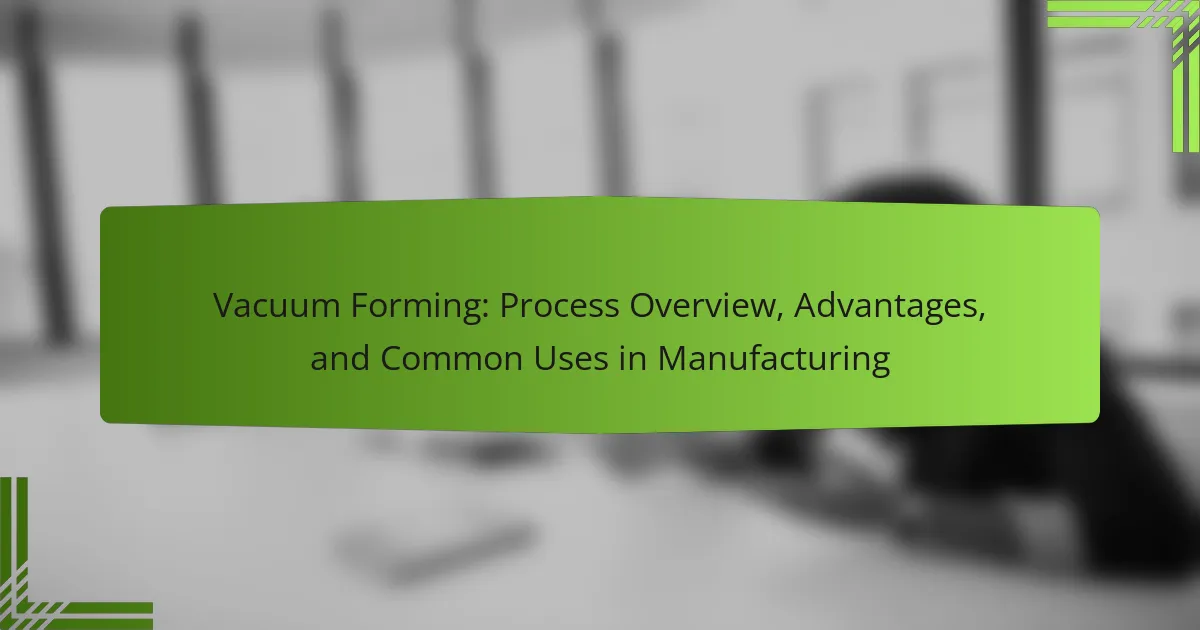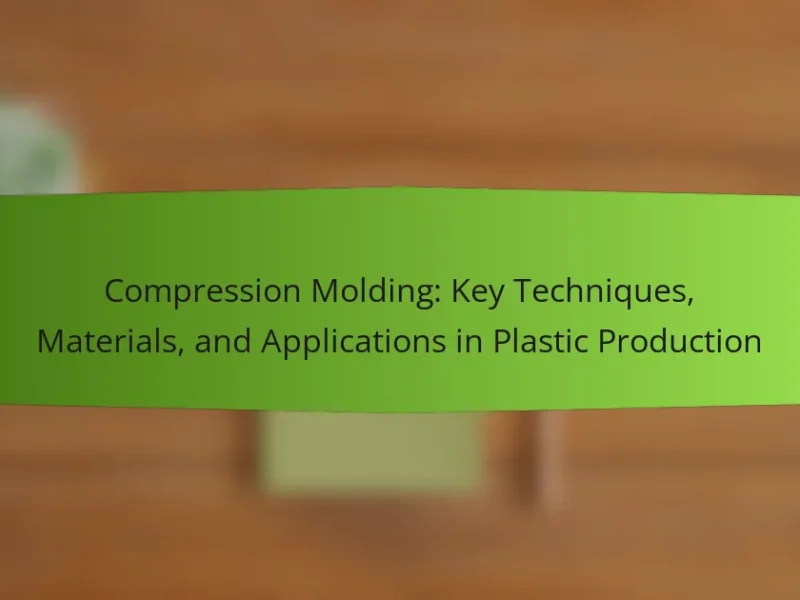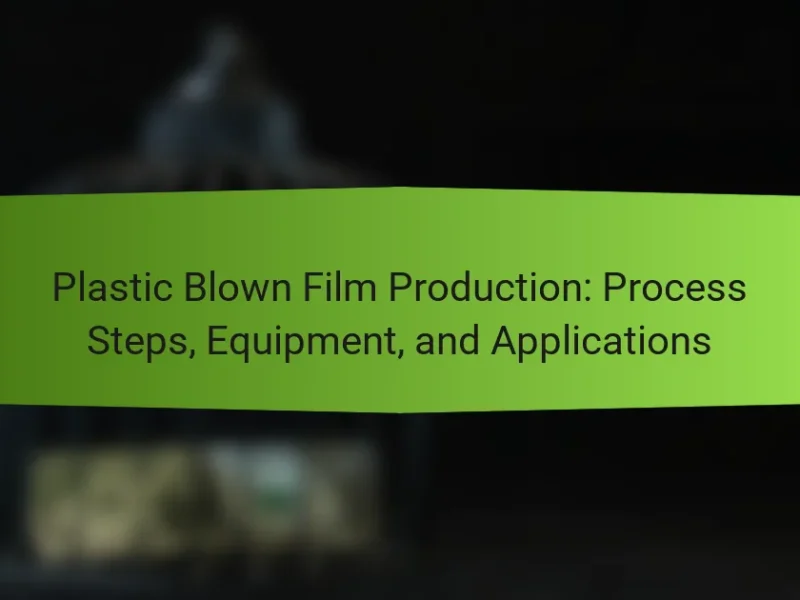Vacuum forming is a manufacturing process that shapes plastic sheets using heat and vacuum to create various designs and products. This technique is essential in industries such as automotive, consumer goods, medical, and signage, where it is used to produce items like interior panels, trays, and device housings. Key advantages of vacuum forming include its efficiency, cost-effectiveness, and ability to create complex shapes. To optimize the vacuum forming process, it is crucial to control temperature, pressure, and material selection, ensuring high-quality outcomes and reduced production times. This article provides an overview of vacuum forming, its advantages, and its common applications in manufacturing.

What is Vacuum Forming?
Vacuum forming is a manufacturing process that involves shaping plastic sheets using heat and vacuum. In this process, a plastic sheet is heated until pliable. Once softened, it is placed over a mold. A vacuum is then applied to pull the sheet tightly against the mold’s surface. This technique creates a variety of shapes and designs. Vacuum forming is widely used for producing packaging, trays, and automotive parts. Its efficiency and cost-effectiveness make it a popular choice in various industries.
How does the Vacuum Forming process work?
Vacuum forming is a manufacturing process that shapes plastic sheets into specific forms. It begins with heating a thermoplastic sheet until it becomes pliable. The heated sheet is then stretched over a mold. A vacuum is applied to remove air between the sheet and the mold. This creates a tight seal, allowing the plastic to conform to the mold’s shape. Once cooled, the formed plastic retains the desired shape. This process is widely used for creating packaging, trays, and components in various industries.
What are the key stages involved in Vacuum Forming?
The key stages involved in vacuum forming are sheet preparation, heating, forming, cooling, and trimming. First, sheet preparation involves selecting and cutting the thermoplastic sheet to the desired size. Next, heating occurs where the sheet is heated until it becomes pliable. The forming stage follows, where the heated sheet is placed over a mold and vacuum is applied to shape the material. After forming, cooling allows the shaped plastic to harden in its new form. Finally, trimming removes excess material to achieve the final product shape. These stages ensure that vacuum forming produces precise and consistent results in manufacturing.
What materials are commonly used in Vacuum Forming?
Common materials used in vacuum forming include thermoplastics such as ABS, polystyrene, and polycarbonate. These materials are favored for their ability to be easily molded when heated. ABS is known for its strength and impact resistance. Polystyrene is lightweight and cost-effective, making it popular for packaging. Polycarbonate offers high durability and clarity. Other materials like PVC and PETG are also used for specific applications. Each material provides unique properties that suit various manufacturing needs.
What are the advantages of Vacuum Forming?
Vacuum forming offers several advantages in manufacturing. It allows for rapid prototyping, enabling quick design iterations. The process is cost-effective for producing large quantities of plastic parts. Vacuum forming also accommodates a variety of materials, including ABS and polycarbonate. The technique can create complex shapes with fine details. Additionally, it has a shorter lead time compared to other molding processes. The equipment required is relatively simple and less expensive. Lastly, vacuum forming produces lightweight components, beneficial for various applications.
How does Vacuum Forming compare to other manufacturing processes?
Vacuum forming is a manufacturing process that uses heat and vacuum to shape plastic sheets. Compared to other processes like injection molding, vacuum forming is generally less expensive and faster for low-volume production. It has lower tooling costs, making it accessible for prototypes and small batches. However, vacuum forming is limited in detail and thickness compared to injection molding. It is also less suitable for complex geometries, which can be better achieved with methods like 3D printing. Overall, vacuum forming excels in simplicity and cost-effectiveness for specific applications.
What cost benefits does Vacuum Forming provide?
Vacuum forming provides significant cost benefits in manufacturing. It reduces material waste compared to other methods. The process allows for the use of less expensive materials, which lowers production costs. Additionally, vacuum forming can produce parts quickly, leading to shorter lead times. This efficiency can result in lower labor costs. The ability to create complex shapes with fewer tools also minimizes tooling expenses. Overall, these factors contribute to a more cost-effective manufacturing process.
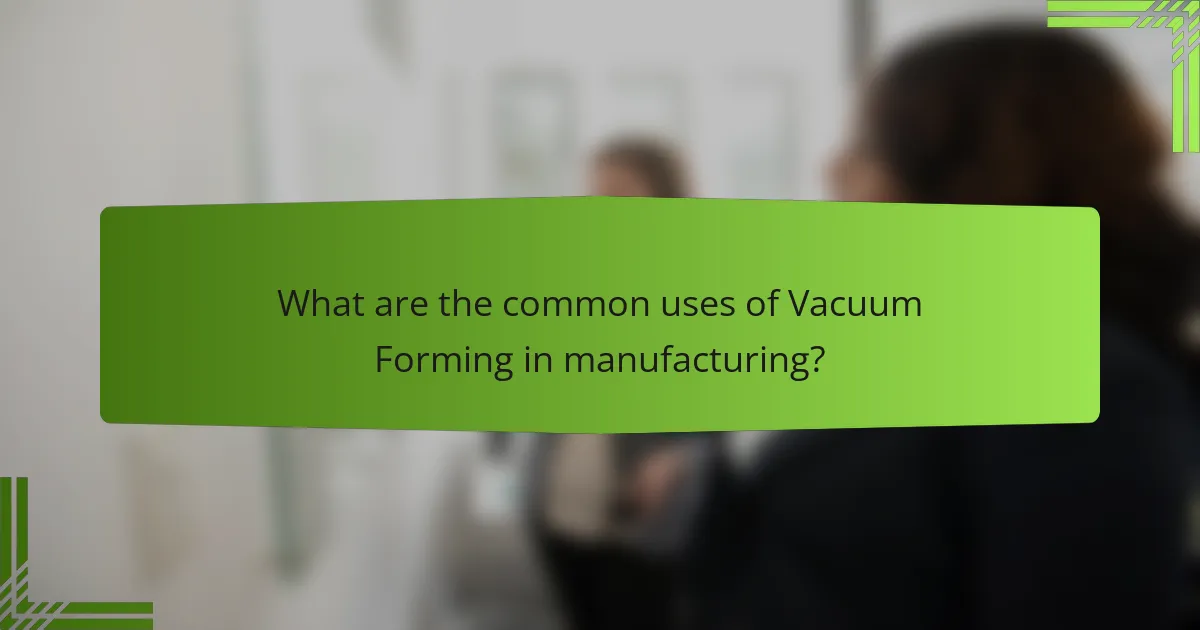
What are the common uses of Vacuum Forming in manufacturing?
Vacuum forming is commonly used in manufacturing for creating plastic parts and packaging. This process is widely utilized in industries such as automotive, where it forms interior panels. In consumer goods, vacuum forming produces trays, containers, and blister packs. The medical field also benefits from vacuum forming for manufacturing custom trays and device housings. Additionally, it is employed in the production of signage and displays. The versatility of vacuum forming allows for low-cost, high-volume production. Its ability to create complex shapes makes it ideal for various applications.
Which industries utilize Vacuum Forming?
Vacuum forming is utilized in various industries including packaging, automotive, aerospace, and consumer goods. In packaging, companies use vacuum forming for creating protective trays and clamshells. The automotive industry employs it for producing interior components and trim parts. Aerospace manufacturers use vacuum forming for lightweight panels and components. Consumer goods companies create custom containers and product displays through this process. Each industry benefits from vacuum forming’s efficiency and cost-effectiveness in producing complex shapes.
What products are typically produced using Vacuum Forming?
Vacuum forming typically produces products such as plastic packaging, trays, and containers. It is also used to create items like automotive parts, medical devices, and display stands. The process allows for the production of complex shapes and designs. Common materials used include PVC, ABS, and polycarbonate. These materials are chosen for their durability and versatility. Vacuum forming is efficient for both small and large production runs. The method is cost-effective for producing lightweight items. Many industries rely on vacuum forming for custom solutions.
How does Vacuum Forming enhance product design flexibility?
Vacuum forming enhances product design flexibility by allowing for the rapid creation of complex shapes. This process involves heating a thermoplastic sheet until pliable, then forming it over a mold using vacuum pressure. Designers can easily modify molds for different product iterations. This adaptability significantly reduces lead times in product development. Additionally, vacuum forming accommodates various materials, enabling diverse aesthetic and functional options. The ability to create lightweight yet durable components further expands design possibilities. Manufacturers benefit from cost-effective prototyping, facilitating innovation in design.
What are some challenges associated with Vacuum Forming?
Some challenges associated with vacuum forming include material limitations, inconsistent thickness, and tooling costs. Material limitations arise as not all plastics can be effectively vacuum formed. Inconsistent thickness can lead to weak spots in the final product. Tooling costs can be high, especially for custom molds. Additionally, achieving precise details can be difficult. The process may also require significant setup time, which can affect production efficiency. Finally, post-processing may be necessary for achieving desired finishes or features.
What common issues can arise during the Vacuum Forming process?
Common issues during the Vacuum Forming process include inadequate heating of the plastic sheet. This can lead to poor forming and uneven thickness. Another issue is improper mold design, which can cause air traps and surface defects. Insufficient vacuum pressure may result in incomplete forming or wrinkles. Additionally, material shrinkage can occur, affecting the final dimensions. Misalignment during the forming process can also lead to inaccuracies in the final product. These issues can collectively impact the quality and functionality of the formed parts.
How can manufacturers mitigate risks in Vacuum Forming?
Manufacturers can mitigate risks in vacuum forming by implementing strict quality control measures. Regular inspections during the forming process can identify defects early. Using high-quality materials reduces the likelihood of failures. Training staff on best practices enhances operational efficiency and safety. Additionally, maintaining equipment ensures consistent performance and minimizes breakdowns. Documenting processes helps in tracking issues and improving procedures. Adopting advanced simulation technologies can predict potential problems before production begins. These strategies collectively reduce waste and enhance product reliability.
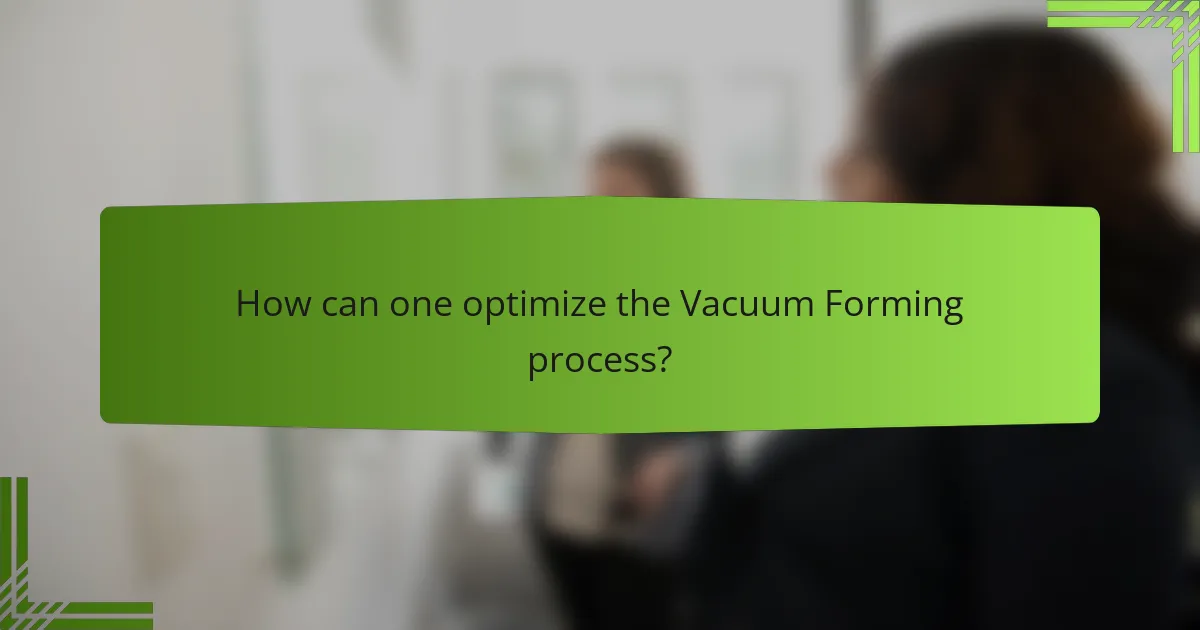
How can one optimize the Vacuum Forming process?
To optimize the Vacuum Forming process, one should focus on controlling temperature, pressure, and material selection. Properly heating the thermoplastic ensures uniform softening, which aids in forming. Accurate pressure application helps in achieving detailed shapes and reducing defects. Selecting the right material with appropriate thickness enhances the final product’s strength and clarity. Additionally, optimizing mold design can minimize cycle times and improve part quality. Implementing these strategies can lead to increased efficiency and better product outcomes.
What best practices should be followed in Vacuum Forming?
Best practices in vacuum forming include selecting appropriate materials. Use thermoplastics suited for the specific application. Ensure the material thickness is consistent for uniform heating and forming. Preheat the material to the optimal temperature to enhance pliability. Maintain proper mold design to facilitate easy part removal. Utilize sufficient vacuum pressure to ensure complete material contact with the mold. Implement cooling methods to stabilize the formed part quickly. Regularly inspect equipment for maintenance to ensure consistent quality.
How can material selection impact the outcome of Vacuum Forming?
Material selection significantly impacts the outcome of vacuum forming. Different materials exhibit varying properties such as flexibility, strength, and temperature resistance. For instance, ABS plastic is commonly used due to its durability and ease of forming. In contrast, polystyrene is lightweight but may lack strength. The thickness of the material also affects the final product’s detail and accuracy. Thicker materials can lead to longer heating times, which may result in uneven forming. Additionally, the choice of material influences the cooling rate, affecting the shape retention of the formed part. Proper material selection ensures that the final product meets specific performance requirements, such as impact resistance or aesthetic qualities.
What maintenance practices are essential for Vacuum Forming equipment?
Regular maintenance practices for Vacuum Forming equipment are crucial for optimal performance. These practices include routine cleaning of the heating elements and molds. Inspecting seals and gaskets for wear is essential to prevent air leaks. Lubricating moving parts reduces friction and wear over time. Checking electrical connections ensures consistent power delivery. Calibrating temperature controls maintains accurate heating during the process. Additionally, monitoring the vacuum system for leaks is vital for efficiency. Following these maintenance practices can extend the equipment’s lifespan and improve production quality.
What tips can improve the efficiency of Vacuum Forming?
To improve the efficiency of vacuum forming, optimize the heating process. Ensure the material reaches the appropriate temperature for forming. Use a consistent heating method to avoid hot or cold spots. Maintain a uniform sheet thickness to enhance material flow. Adjust the vacuum pressure for better material adhesion to the mold. Implement proper mold design to facilitate air escape during forming. Regularly maintain equipment to prevent downtime and issues. Monitor cycle times to identify areas for improvement. These practices can significantly enhance the efficiency and quality of vacuum forming operations.
Vacuum forming is a manufacturing process that shapes plastic sheets using heat and vacuum to create various products such as packaging, trays, and automotive parts. The article provides a detailed overview of the vacuum forming process, including key stages like sheet preparation, heating, forming, cooling, and trimming. It discusses the materials commonly used, advantages such as cost-effectiveness and design flexibility, and comparisons with other manufacturing methods. Additionally, it addresses challenges, common issues, and best practices to optimize the vacuum forming process, highlighting its applications across various industries.
